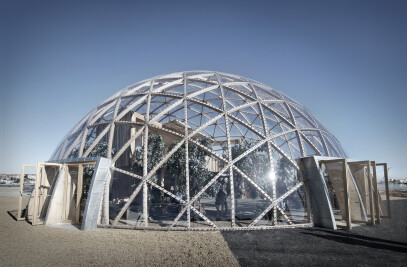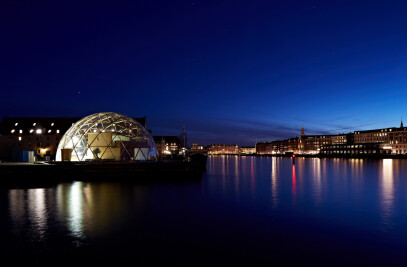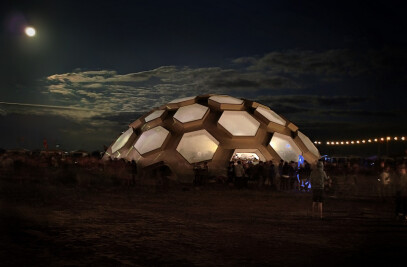The droplet is a fully transparent pavilion resembling a resting water droplet. The structure is an engineered self-supporting dome, which can function as a garden pavilion, greenhouse, mobile exhibition pavilion, recreational space, etc.
The droplet is born out of a desire to create a high-quality contemporary alternative to traditionally glazed greenhouses, though with the benefit of a sturdy and shockproof facade.
The droplet consists of sheets in transparent 6mm polycarbonate. The sheets are assembled with stainless steel nuts and bolts which allows for an easy and fast build and disassembly.
The curvature of the structure is generated by the rhombus shapes of the flat sheets and by displacing the holes slightly between the overlapping sheets in a controlled manner. The curvature of the facade gives the pavilion incredible strength, which allows for the simple and thin facade without the need for internal load bearing walls or steel frames.
In order to reach the required precision, CNC-milling is used for the sheets, which are also dimensioned to take full advantage of standard sized polycarbonate sheets from the manufacturer.
With an oval profile and circular footprint the design maximises available floor space and gains standing height along the inside rim of the facade. The polycarbonate sheets are designed to overlap in a fish scale fashion, keeping the structure wind and waterproof, without the need for seals or caulk.
The droplet can be tailored to accommodate individual needs - from the type of foundation to size, shading, facade solution, transparency level and interior layout.
To give examples as to how the droplet can be tailored, the droplet can be fitted with aluminum or wooden doors and a PEHD thermoplastic foundation ring extended 50cm into the ground to keep rodents at bay. Colors can be varied on the aluminum doors and the foundation.
The primary choice for the facade is a 6mm UV-protective polycarbonate, but polycarbonate facades in translucent U-channel sheets, solid sheets in a variety of colors or even sheets in plywood is available.
It is possible to add an awning to the droplet to provide shade on sunny days. The off white cotton awning will be available in several sizes and is easily attached to the droplet with stainless steel hooks on the inside of the facade. The same system can be used for a cotton tent, providing privacy and allows one to use the pavilion as a guest house.
The droplet can be fitted with a base made of CLT (Cross Laminated Timber). The base consists of 3 interlocking pieces and ensures that the droplet is kept grounded during stormy weather and creates an instant flooring. This type of foundation is an ideal solution if the droplet is to be used as a mobile exhibition pavilion for commercial use.
DESIGN PROCESS
For Kristoffer Tejlgaard personally, the fascination with domes, at first geodesics, started with the American architect Buckminster Fuller and his ideas about ecological design. Since Kristoffer erected his first geodesic dome at Roskilde Festival in 2011, several other geodesics has been added to the portfolio. An earlier project, Dome of Visions is a construction of the geodesic type. A method of engineering with which one can create strong and sturdy, but still delicate designs, by deliberately orchestrating the compressive and tensile forces of materials.
Today, the geodesic dome occupies a place in the history of architecture, partly due to Buckmister Fuller. During the fifties and sixties, Fuller used the geodesic dome structure in his work and theorized on geometrically optimal ways in which to construct domes. It was not until recently, that investigations revealed that the geometry he used in architecture originated from nature. Fuller therefore gave name to the family of carbon molecules of which the molecule c60 is a part. They are today known as “Buckyballs” or “Fullerenes”.
Fuller foresaw the scarcity of resources we are facing today. This made him call for “a design revolution” which could enable all of us to do more with less resources. According to Fuller, one source of improved resource efficiency was intelligent constructions. Fuller shared this perspective on architecture with newly established hippie communities who tapped into his knowledge of geometry and set out to construct cheap and resource efficient houses. The geodesic dome is therefore considered an icon of alternative architecture today.
The legacy of Buckminster Fuller lives on in the philosophy at the Copenhagen-based architecture studio, Atelier Kristoffer Tejlgaard. Building on this legacy, AKT keeps challenging the established construction industry in their approach to architecture and aims to keep experimenting in order to optimize the way we consume resources in our buildings. For this end, there are several approaches.
Specifically, in relation to the droplet, the design leaves the geometric principles of the geodesic dome, with a desire to meet modern industrial production methods and material dimensions, while retaining a high aesthetic quality.
Through 3D-modelling, it was possible to generate a geometry based on rhombuses, more suited for industrial production. With this geometry the material waste could be reduced by approx. 30% compared to a geodesic dome structure based on pentagons and hexagons.
Along with the above mentioned properties, the droplet is designed for disassembly. This way, all the materials used in the structure can easily be recycled when the pavilion no longer serves a purpose.
While going from a hemisphere to an oval form provides several advantages, such as full standing height along the inside rim of the facade, it also poses new challenges in the design phase.
The desired sheet sizes for the droplet is adapted to standard polycarbonate sheets, in order to take full advantage of the material. As the sheets are created from flat extruded polycarbonate and not curved cast polycarbonate, there is a limit to how much one can push the curvature, while retaining required strength for the construction and a beautiful curved line along the facade.
The way this issue was resolved was by subdividing the sheets in a manner that gave the desired curvature while creating the least possible waste of material. After seeing a physical manifestation of the geometry working in a 1:20 scale model and reaching proof of concept as to how much you can bend the individual sheets without a breach, the prototype in full scale was build.

































